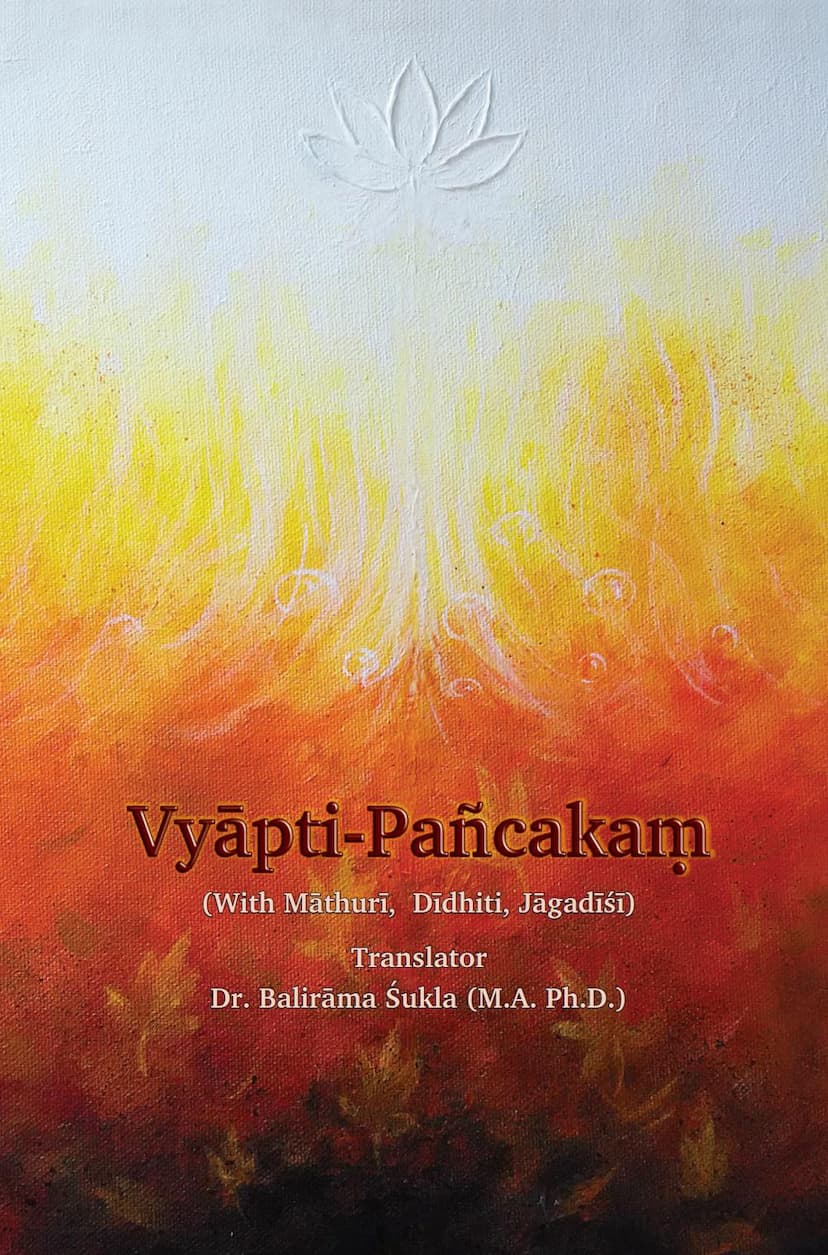Vyaptipanchakam
Added to library: September 2, 2025

Summary
Here is a comprehensive summary of the Jain text "Vyāpti-Pañcakam" based on the provided information:
Book Title: Vyāpti-Pañcakam (Five Definitions of Vyāpti)
Author(s) of Original Text: Gangesa (founder of Navya Nyāya), Mathurānātha (author of Mathuri commentary), Raghunātha (author of Didhiti commentary), Jagadiśa (author of Jagadīśī commentary).
Publisher: Shrutbhuvan Research Centre, Pune.
Translator: Dr. Balirāma śukla (M.A., Ph.D.).
Core Subject: The book focuses on the concept of Vyāpti (invariable concomitance or universal relation) in the context of Navya Nyāya, a school of Indian logic and epistemology. It presents and analyzes five critical definitions of Vyāpti.
Navya Nyāya Context:
- The introduction highlights the evolution of Indian logic, with Navya Nyāya emerging as a new, highly technical and precise form of logic, stemming from earlier Nyāya and influenced by Buddhist and Jain logic.
- Navya Nyāya is characterized by its focus on Pramāṇa (means of valid knowledge) rather than Prameya (objects of knowledge).
- It emphasizes the use of precise technical terms and introduces new conceptual categories like pratiyogita (counter-positiveness) and avacchedakatā (determinant-hood) to express subtle distinctions and circumstantial changes in reality.
- The complexity of Navya Nyāya, due to its technical vocabulary and rigorous argumentation, is acknowledged, explaining its reputation for intellectual challenge and occasional criticism of making simple things complex. However, the text argues that these terms are essential for precise distinctions that ordinary language cannot convey.
The Five Definitions of Vyāpti: The book critically examines five definitions of Vyāpti, originating from Gangesa's Tattvacintāmaṇi and elaborated upon by his commentators. These definitions aim to precisely define the invariable connection between the hetu (reason/middle term) and the sādhya (predicate/major term) in an inference. The text delves into the nuances and potential flaws (avyāpti - too narrow, ativyāpti - too broad, asambhav - impossibility) of each definition, often engaging in a debate between the perspectives of Mathurānātha and Raghunātha.
The five definitions, presented in Sanskrit and translated into English, are:
- Sādhyābhāvavadavṛttitvam: The non-occurrence (of the reason) in the locus of the absence of that which is to be established.
- Sādhyavaddhinnasādhyābhāvavadavṛttitvam: The non-occurrence (of the reason) in the substratum which possesses the absence of that which is to be established and which is different from that which has that which is to be established.
- Sādhyavatpratiyogikānyonyābhāvāsāmānādhikaraṇyam: The not co-existence (of the reason) with such a mutual absence which has the substratum of that which is to be established as its counter-positive.
- Sakalasādhyābhāvavanniṣṭhābhāvapratiyogitvam: The counter-positive-ness of the absence which resides in all substrata of the absence of that which is to be established.
- Sādhyavadanyāvṛttitvam: The non-occurrence (of the reason) in the substratum which is different from that which has that which is to be established.
Commentaries and Analysis: The book includes commentaries:
- Mathurī (by Mathurānātha): Serves as an initial entry point into the system.
- Didhiti (by Raghunātha Siromaṇi): A highly influential commentary on Gangesa.
- Jāgadīšī (by Jagadiśa Tarkālaṅkāra): A sub-commentary on Didhiti, considered by some to be superior to Didhiti itself in certain aspects, particularly in the interpretation of the fifth definition.
The detailed analysis in the book (especially the extensive commentary sections) explores:
- The precise meaning of technical terms and their grammatical constructions.
- The logical reasoning behind the formulation of each definition.
- The potential shortcomings of each definition, illustrated with examples of valid and invalid inferences.
- The attempts by commentators to refine or defend these definitions against criticisms.
- The debate between different philosophical schools, particularly the critique of Mimāṁsakas by Gangesa.
- The text also discusses the applicability of these definitions to different types of inferences, including kevalānvayi (pure affirmative) inferences, where the absence of the sādhya cannot be established.
Key Figures: The introduction and appendices provide brief biographies of prominent figures in Navya Nyāya, including:
- Gangesa: The foundational figure of Navya Nyāya.
- Mathurānātha Tarkavāgisa: Commentator on Gangesa and author of Mathuri.
- Raghunātha Siromaṇi: A pivotal figure who refined Navya Nyāya through his commentary Didhiti.
- Jagadiśa Tarkālaṅkāra: Author of Jagadīšī, a significant sub-commentary.
- Other influential scholars like Pakṣadhara Miśra, Yajñapati Upādhyāya, Viśvanātha Pañcānana, and Gadādhara Bhattācārya are also mentioned in the historical context of Navya Nyāya development.
Purpose and Significance: The book aims to provide an accessible English translation and analysis of these crucial definitions of Vyāpti, making a complex aspect of Navya Nyāya logic available to a wider audience. It highlights the sophisticated analytical tools and precise language developed within Indian philosophy to understand the nature of valid reasoning and knowledge. The translator, Dr. Balirāma Śukla, worked on this translation with the assistance of others, and the publication is dedicated to making the Navya Nyāya system better understood globally.
In essence, "Vyāpti-Pañcakam" is a scholarly exploration of the fundamental concept of invariable concomitance, essential for inference in Indian logic, presented through rigorous analysis of five key definitions with extensive commentary and historical context.